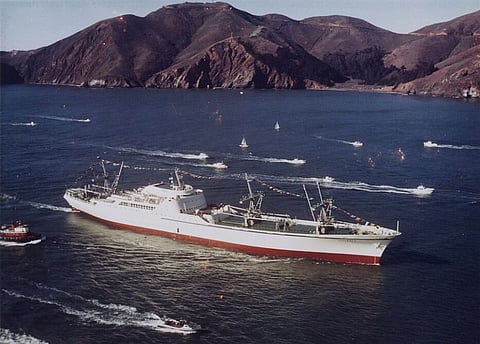

Right before my very eyes, was a most wonderful sight that stopped me in my tracks. Towering above the rabble and noise of Pier 13 South Harbour in Manila was the 182-metre, nuclear-powered passenger cargo ship Savannah, right on the opposite berth to us!
This was November 1967, and as the new third officer of the diminutive and elderly cargo passenger ship Francis Drake, I had already absorbed the magazine articles that had been ablaze with praise for this streamlined yacht-styled ship. And here she was!
At 16:00, when Savannah's 90 passengers started returning from their shore excursions, I made the move. Dressed in full uniform, and carrying a large envelope marked "ORDERS" (containing a lunch menu), I started my brisk march across the pier.
Despite the official crowd including security staff at the bottom of Savannah's gangway, I marched purposefully through them and straight up the gangway. Bluff used to work then. Nowadays, you need a badge, a gun, a peaked cap, and an Alsatian dog.
Enterring directly into the accommodation, I was gobsmacked by the bright orange "art deco" style of the upholstery and space-age styling of the lounge and reception areas. This made our old 1948-built vessel look like a floating relic out of a bleak Charles Dickens novel.
Of course it was only a few minutes later when they realised I was an imposter and apprehended me and politely escorted me off the vessel, despite my protests that I had mistaken their ship as mine. Nevertheless, I had made it on board the world's best vessel and was totally impressed with my level of bluffing for the day.
Savannah was a showcase of US President Dwight Eisenhower's "Atoms for Peace" initiative. Considering at that time the very mention of the word "atom" made people instinctively hold their heads and duck, this initiative was a good one. She was designed in the 1950s and handed over in 1960.
The Germans then built the 172-metre Otto Hahn in 1964 and the Japanese built the 129-metre Mutsu in 1969, and both were nuclear-powered like Savannah. Otto Hahn managed to clock up 250,000 sea miles (11 trips around the world) on a very impressive 22 kilograms of uranium, with no greenhouse gas emissions! Not even the superior airline industry could match that little gem.
The biggest and most advanced nuclear cargo vessel, the 260-metre Russian behemoth Sevmorput, was built in 1988 (almost 30 years after Savannah) and is still reported to be operational within Russia as an icebreaking cargo vessel.
Of course, success stories for the marine industry are generally short-lived and in 1972, the beancounters within the US Administration decided that losing US$2 million a year with Savannah was just not on.
When decommissioning Savannah in 1973 when oil was US$20 a tonne, they had no idea that just one year later, the Arab oil embargo would propel bunker oil over US$85 a tonne. Small change indeed by today's standards.
Savannah was capable of circling the earth 14 times at 20 knots without refuelling. Nowadays, a similar 14,000 kW of installed power would cost around US$189 million in just bunker fuel alone, with corresponding huge emissions!
The US, Japan, and Germany have decommissioned their nuclear vessels and indeed, Otto Hahn was re-engined and operated successfully as a cargo vessel. The US, China, and Russia still have a number of nuclear-powered warships that have proven successful in matching safety, operational range, and environmental acceptability.
It was not a smart move to close down the nuclear engineering faculty at the University of NSW. But with petulant government bans prevailing, what else could they do?
In 2020, the NSW Government bi-partisan committee endorsed a close re-evaluation of our nuclear bans imposed 38 years ago as the technology, particularly safety aspects, has improved significantly since then. Those interested should join the Australian Nuclear Association (ANA). Their news sheets are very enlightening.
Small and micro modular reactors (SMRs and MMRs), the latest development in nuclear technology with lower cost and far greater levels of safety, are being put on barges and plugged into remote cities in Russia. Why not copy this success in Australia for our remote areas?
Certainly the upcoming one-day nuclear seminar in Mount Isa on October 4 should be a start of sensible discussion. New remote mines are lumbered with a huge cost in the hundreds of millions just to connect the sprawling renewable energy transmission network. They could eliminate this obscene connection fee by getting the truck mounted 5mW MMR units brought to site.
An Australian coastal nuclear-powered ship for defence activities makes very good sense.
The diminutive Westinghouse 5mW air-cooled MMRs will keep a sizeable ship operating for eight to 10 years, and power up to 3,000 homes when tied up to a port. No other power source comes close.
So now with over 160 nuclear powered vessels zigzagging all over and under the oceans occupying 70 per cent of the planet, and then if you add the 32 countries with nuclear and add the 40 countries seriously considering nuclear, it only leaves small enclaves of the planet with concentrated combinations of ignorance, arrogance, and stupidity… like Australia, for instance!
This lucky country, having such gifts as an abundance of uranium and thorium, is terribly unlucky in having the AU$1.1 billion ABC marketing machine feeding oxygen to the plethora of malcontents, angry and unhappy sods around the country that want to bring the place down.
"Yes, and how many times can a man turn his head
And pretend that he just doesn't see?
The answer, my friend, is Bowen in the wind.
The answer is Bowen in the wind."
Apologies to Bob Dylan.
